Opinion
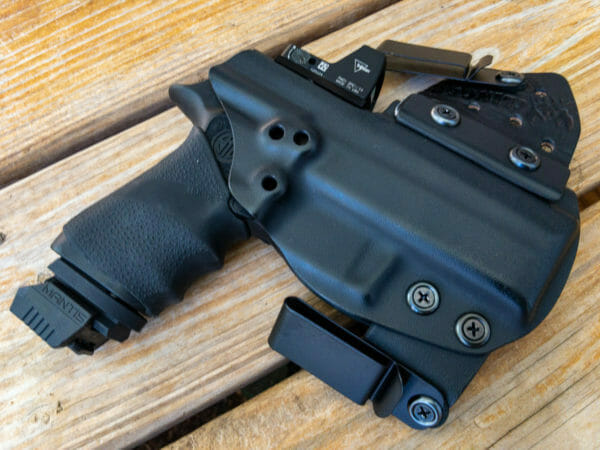
I’ve been learning how to draw. No, not with colored pencils or finger paints—I suck at that. I’ve been learning how to draw, or more accurately, relearning how to draw from legitimate concealment.
I’ve been eating some portions of humble pie while experimenting with the new Mantis X10 magic computer training tool recently, and it’s exposing plenty of things I need to work on. Even before the upcoming New Year’s Resolution season.
Sure, it feels great to practice with an OWB rig with no cover garment. We can rack up impressive times on the shot timer and make ourselves feel good. Too many of us who carry a gun live in a phantasmagoria of rising to the occasion, action movie scenes, and optimism. Hey, if something ever goes wrong when we’re carrying concealed, the motions are pretty much the same, so it’ll work out, right?
Wrong.
Real and quantifiable practice under the exact same conditions as your daily carry just might expose some problem areas.
That’s a good thing as it’ll give you the opportunity to tweak your setup and skills before ever needing to use them. You don’t want to find out about little details that can wreck your self-defense plan under “live range” conditions.
Anyway, using the new Mantis X10 device, which now features holster draw training capability, I’ve been doing all sorts of experimentation with my carry guns, holsters, and covering clothing.
The new device is about half the size of the original and mounts on a magazine using optional replacement bases available from the company. That means you can use your standard holster and train with this gear at home via dry fire or at the range with all the associated flash and bang.
The sensor unit and companion smartphone app analyze every component of your draw. The app even creates a graphical representation of the travel of your handgun from the time it leaves the holster to the time you fire the shot, so you can easily spot erratic or wasted movement. It also times three main components of the holster-to-fire sequence.
- The time from the starting buzzer to achieving a full grip on the firearm.
- The time from getting a grip to clearing the holster and getting the muzzle pointed downrange.
- The time from muzzle downrange to the shot on target.
Seeing your elapsed time for each segment allows you to figure out where you need to refine your technique, and maybe your gear. For the context of this article, I’ll focus on what the first two measurements told me. How long does it take me to react, uncover my pistol, and get it out from concealment and pointed downrange at waist level?
Here are some learnings that all this techno-science exposed for me.
Clothing Sucks
Having and using the system forced me to practice using my real everyday carry setup. Since it detects dry fire, I could train right at home using a verified unloaded pistol, my normal holster, and the clothes I normally wear when carrying. The home-based training also made it easy to make changes and try different configurations like shirts and jackets.
I normally carry inside-the-waistband (IWB), and since I live in the sauna known as Sub-Carolina, most of the year, my cover garment is an untucked t-shirt, polo, or fishing-type button-down shirt. As it turns out, the specifics of shirt style and material make a lot of difference.
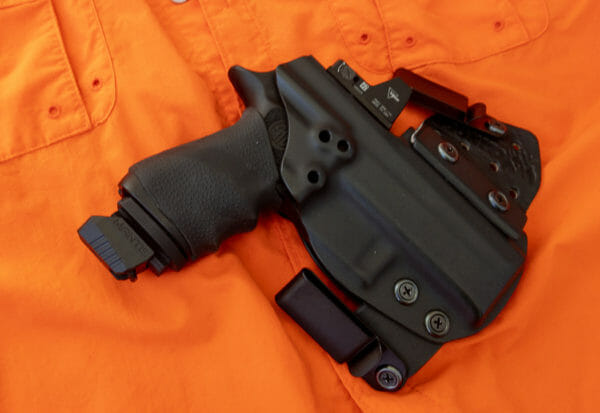
A little vanity can kill you. Some of my Columbia shirts are a bit slimmer in the torso. While they’ll still easily cover an IWB rig, those tighter shirts caused a lot of time delay. When comparing tighter versus very loose shirts, the number of “failed” draws where things got tangled up skyrocketed. The number of “slow” draws where I spent extra tenths of seconds getting the shirt out of the way also increased substantially. I found that clothing fit could easily account for three or four-tenths of a second in the draw time. When the standard goal is 1.5 seconds, three or four-tenths fooling around with clothing makes a big difference.
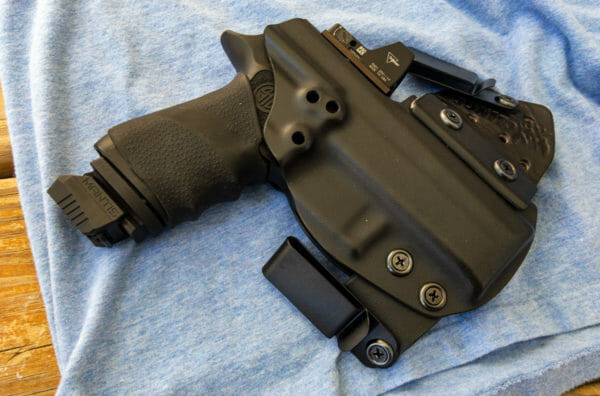
Material matters. I found that a quality cotton shirt was the fastest for me. Your mileage may vary. It had enough weight to “assist” the “get the material the heck out of the way” process before I could draw. It was also less likely to catch and hang up on gun and holster surfaces. Some of my ultra-light fishing shirts flopped all over the place when I was going for speed and actually slowed me down. I think the flowy material just likes to go where it wants, kind of like Saran wrap. I still use these as they’re great for concealment and blend in well, but I’m glad I’ve been practicing with them. It forces you to learn a really aggressive precise technique that will work on more forgiving fabrics too.
Live Inventory Price Checker
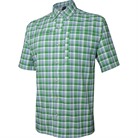
|
Men's Short Sleeve Speed Concealed Carry Shirts - Short Sleeve Speed Concealed Carry Shirt Leaf Small | Brownells.com | $ 64.95 $ 19.99 |
|
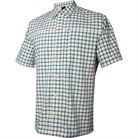
|
Men's Short Sleeve Speed Concealed Carry Shirts - Short Sleeve Speed Concealed Carry Shirt Sky Medium | Brownells.com | $ 64.95 $ 48.71 |
|
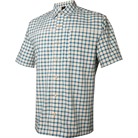
|
Men's Short Sleeve Speed Concealed Carry Shirts - Short Sleeve Speed Concealed Carry Shirt Sky Small | Brownells.com | $ 64.95 $ 19.99 |
|

|
Concealed Carry Ignition Set For 1911 Handguns - Concealed Carry Ignition Set Silver | Brownells.com | $ 167.99 |
|
Don’t sweat it. When doing some of this at an outdoor range, I found that those cotton shirts that worked so well in air conditioning weren’t so hot when they started to get a bit sweaty and sticky. More failed draws and clothing vs. gun hangups resulted. Again, the fix is to learn and train for an aggressive cover garment clearance technique. If you need to pull that shirt up four inches in perfect conditions, train to yank it up to your armpits to account for clothing gotchas.
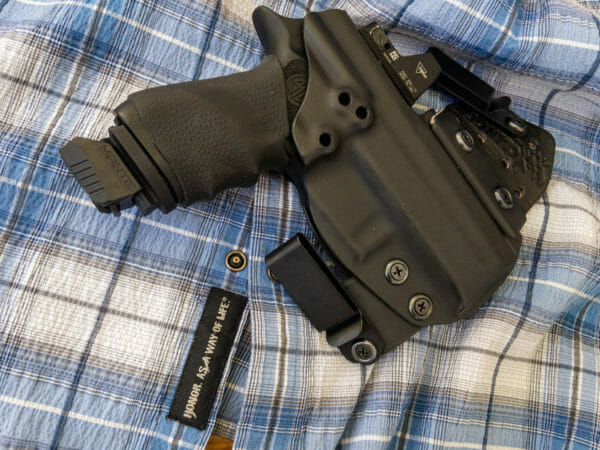
An Inch Matters
Insert your own jokes here—we’re not going there. But an inch makes all the difference.
I’m not talking about size; I’m talking about placement. Carrying strong-side IWB way towards the back, like the five-o’clock position, is convenient and comfortable. However, every inch you move towards the back results in an exponentially harder draw from concealment. While open jackets are more forgiving, a shirt that has to be lifted can cause real problems when the gun is that far back.
When I started moving the holster back to the four and five o’clock positions, my error rate skyrocketed, and speed dropped significantly. Just an inch or so difference was slowing me down by a few tenths of a second because of the extra time and reach required to get my cover shirt out of the way.
Appendix Positioning
While I still carry IWB in the three-o’clock position, give or take, I’ve been experimenting with the appendix position IWB carry. I still don’t care for the muzzle jamming into my thigh when I sit, but I have to admit appendix carry is fast. Really fast.
Part of the speed-of-draw increase results from the holster position. The pistol is easy to reach with your firing hand, even though you have to bend your firing-hand wrist a bit unnaturally. But what makes the difference is the ease of getting a cover garment shirt out of the way. Being much closer to the support-side hand means it’s easy to reach and raise the shirt. I found that my tighter shirts presented no problem when carrying the gun in the appendix position. It’s very forgiving in that respect.
Overall, I knocked a couple of tenths of a second off my strong side IWB times just by moving to the appendix position. I’m not a convert yet, but it’s tempting.
Rubbers?
I’ve been testing a Sig Sauer P320 XCompact pistol with a red dot sight. I love the pistol, but this first version comes with a medium-size frame. I can already tell that the perfect configuration for me will be the large frame, but they’re not yet available, so I bought a Hogue universal grip sleeve and installed that for the meantime.
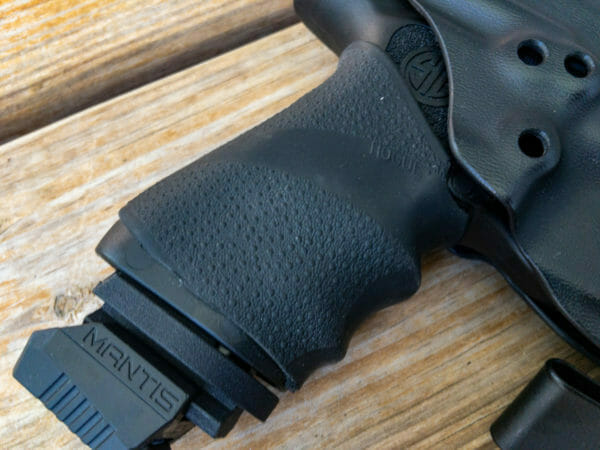
I love these grip sleeves. The gun shoots great with it, and it solves my grip size challenge. However, the rubber material can provide a little extra stickiness from the draw, depending on the type of shirt you’re wearing. Even rough-textured polymer is slippery against any clothing layer, so the sleeveless pistol comes right out and won’t stick on clothing. With some materials, I experienced a bit of draw stickiness resulting from the grip sleeve, especially when things were a bit sweaty. If you use one, be sure to test it out with your normal covering shirts.
The Bottom Line
This whole exercise reinforced the importance of testing and practicing in realistic conditions. By realistic, I simply mean wear the gun as you would on a normal day. Do lots of draws from concealment using the actual shirts you’ll use on the street. Don’t practice with your loose range clothes and especially don’t practice without a cover garment. Don’t cheat and practice with a Shoot-Me-First vest if you normally use a closed shirt for cover. Don’t assume you’ll rise to the occasion. You won’t. Some quality time at home experimenting might expose some gotchas you didn’t know you had.
About
Tom McHale is the author of the Practical Guides book series that guides new and experienced shooters alike in a fun, approachable, and practical way. His books are available in print and eBook format on Amazon. You can also find him on Facebook, Twitter, Instagram, and Pinterest.


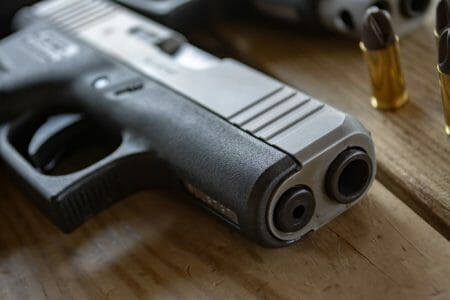



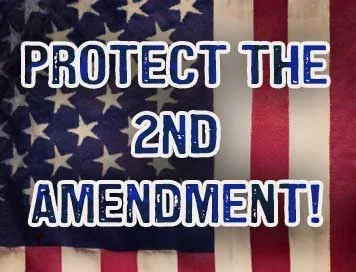

Great article! Very useful. And woe is me because I just found out that that extra inch that I just can’t seem to do without can cause problems when drawing from the holster! The thing to be cognate of is that accuracy in your motion accounts for more than does speed. Do everything accurate, and right, and the speed will come naturally. When someone starts shooting, and it’s your ass in the line of fire, the first thing to do is to take cover. Remember not to panic. Chose your moment, and make your movements deliberate. The thing that will… Read more »
While this appears to be an awesome holster, no two people are the same and, the “perfect holster” is as individual as you are. My “perfect holster” comes from Garrett Industries. It’s a leather lined Kydex holster called Silent Thunder. Garrett Industries is a Texas based company, specializing in low profile, quality holsters that won’t mar the finish of your carry weapon. They have hundreds of 5 star reviews from law enforcement, retired military and, civilians. Sometimes I have to elbow check to make sure I’m carrying because, it’s that comfortable and, I carry everyday. I’d put their holster up… Read more »
4 years ago. I am a big boy. I carry mine in the space between my belly button and the inside of my hip right in the well. The loose shirt and fat belly helps hide it pretty good. If I am in a confrontational situation I keep my hands on my belt right in front of me. I grab my t-shirt with my left hand and place my right hand on my pistol over the t-shirt. Lift up and raise the left hand and the gun is right there to draw with your right hand already in place. Draw,… Read more »
just get involved in IDPA comp., all draws are from concealment and in regards to rubber grips, get your hand nice and wet and see how good that rubber grip is. i had Hogue rubber grips on my comp gun and there was a stage with water and your hands were sopping wet, i picked up my pistol and started to engage targets my pistol almost jumped out of my hands, the best is skate board tape, i have it on all my firearms, your choice